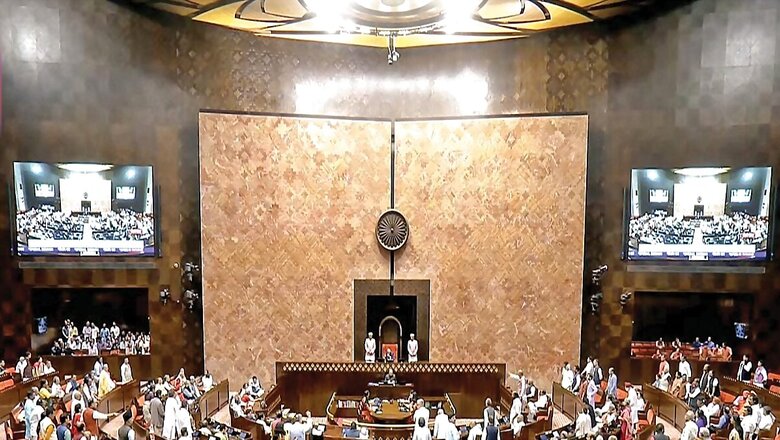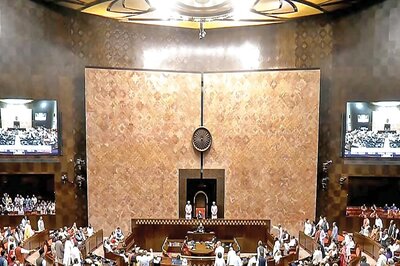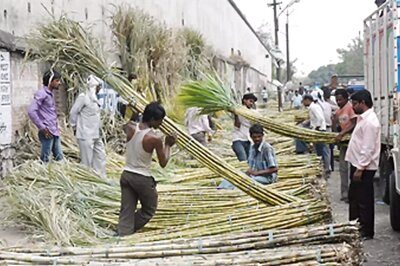
views
The Rajya Sabha polls in three states – Karnataka, Uttar Pradesh and Himachal Pradesh – brought the electoral energy ahead of the mega Lok Sabha elections. The results declared the ruling Congress winner in Karnataka by bagging three of the four seats while the BJP secured one. In Uttar Pradesh, the BJP was a clear winner with eight of the total 10 seats in its kitty. The Congress in Himachal Pradesh is in a spot after six of its MLAs cross-voted in the BJP’s favour.
Let’s look at the numbers.
After Tuesday’s polls, the BJP won 30 (20 unopposed and 10 in the elections) of the 56 Rajya Sabha seats that fell vacant in April. This would take the party’s tally in the Upper House to 97, and that of BJP-led NDA to 117, that is four short of the majority mark of 121 in the 240-member House once all 56 members are sworn in.
BJP now has 97 members in the Rajya Sabha, which makes it the single largest party, followed by Congress with 29 members. Due to cross-voting in Himachal Pradesh and Uttar Pradesh, two additional seats from the states will take party’s tally in Rajya Sabha to 97.
Forty-one of the 56 members were elected unopposed, which included former Congress president Sonia Gandhi, BJP chief JP Nadda, Ashok Chavan and Union ministers Ashwini Vaishnaw and L Murugan.
The BJP won the highest number of 20 unopposed seats, followed by the Congress (6), Trinamool Congress (4), YSR Congress (3), RJD (2), BJD (2) and NCP, Shiv Sena, BRS and JD(U) one each.
After Tuesday’s elections, the BJP is the single largest party with 97 members, followed by Congress with 29 members, Trinamool Congress with 13 members, DMK and AAP with 10 each, BJD and YSRCP with nine seats, BRS with seven, RJD with six, CPM with five, and AIADMK and JD(U) with four each.
Party Position State-Wise
Uttar Pradesh
There are 403 assembly seats but the current strength of the assembly is 399. To win a Rajya Sabha seat, a candidate required 37 preference votes in the state.
The BJP had fielded eight candidates and the Samajwadi Party (SP) three for the Rajya Sabha elections on Tuesday. Both BJP and SP have maximum members in the assembly, with 252 MLAs and 108 MLAs respectively. The Congress, an alliance partner of the Samajwadi Party, has two seats.
The BJP candidates who won the RS polls are former Union minister RPN Singh, former MP Chaudhary Tejveer Singh, state party general secretary Amarpal Maurya, former state minister Sangeeta Balwant, party spokesperson Sudhanshu Trivedi, former MLA Sadhna Singh, former Agra mayor Naveen Jain and local industrialist and former SP leader Sanjay Seth.
From Samajwadi Party, actor-turned-politician Jaya Bachchan secured most votes, with 41 members voting in her favour.
Karnataka
There are total 224 members in the state assembly. To win a seat in the Rajya Sabha, a candidate is required 45 preference votes to win.
The Congress fielded Ajay Maken, Syed Naseer Hussain and GC Chandrasekhar, who emerged winners after securing 47, 47 and 45 votes, respectively. From the BJP, Narayansa Bandage was elected to the Rajya Sabha. BJP MLA ST Somashekar voted for Congress candidate Ajay Maken, while another MLA Arbail Shivaram Hebbar abstained from voting. JDS’ D Kupendra Reddy was also in the fray.
The BJP fielded one candidate for the Rajya Sabha elections. It has 66 MLAs in the Karnataka Assembly while the JDS has 19 MLAs. The Congress, which had fielded three candidates, has 135 MLAs in the assembly.
Himachal Pradesh
There are 68 members in the state assembly. This means a candidate needs 35 first preference votes to win. The BJP has 25 MLAs in the Himachal Pradesh assembly while the Congress has 40 MLAs.
The BJP’s win in the lone Rajya Sabha seat due to cross-voting is a big upset for the ruling Congress in Himachal Pradesh.
Jairam Thakur, the former chief minister, was expected to win, but the six Congress MLAs and three Independent MLAs reportedly voted for the BJP, Harsh Mahajan.
How Rajya Sabha Election Results are Calculated?
The MLAs elect the Rajya Sabha MPs through proportional representation process with single transferable vote system (STV). Each MLA’s vote is counted as one.
MLAs need to choose candidates in order of their preference. If the MLAs choose a particular candidate as their first choice, they get elected while the remaining votes go to the next candidates, but with a lesser value. MLAs can also vote for candidates from other parties.
A candidate needs a required number of votes, which is known as quota or preference vote, to win. The formula is = [Total number of votes/ (Number of Rajya Sabha seats + 1)] + 1.
If more than one seat needs to be filled, the formula is the total number of votes required for a candidate is = [(Number of votes x 100) / (Vacancies + 1)] + 1.

















Comments
0 comment